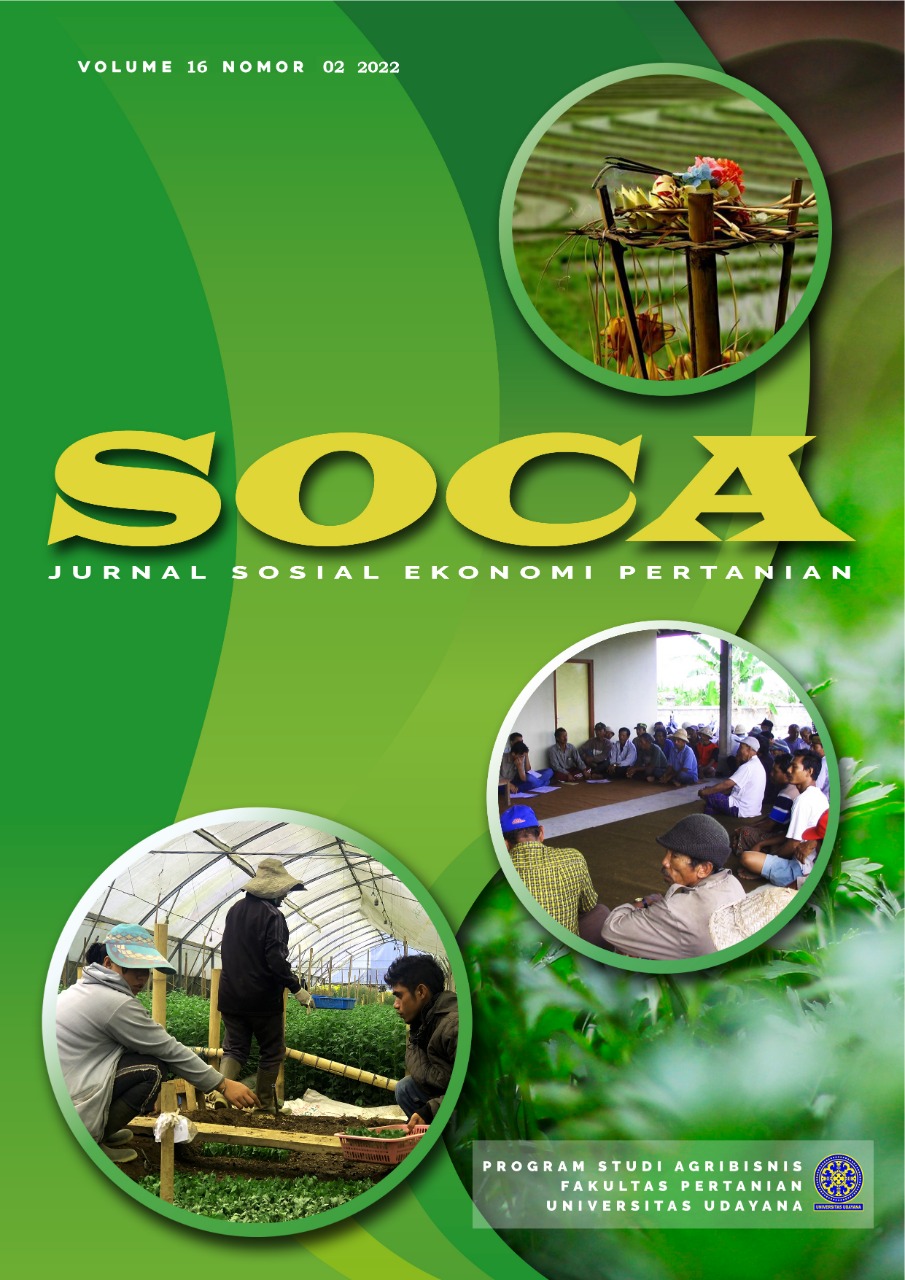Financial Feasibility of Citronella in The Reforestation Area
Abstract
Sawang District in North Aceh Regency, has a large forest area. During the sustained conflict in Aceh, most of forest areas were degraded and greatly affected the destruction of the forest ecosystem. The citronella plants on reforestation land have a high potential to be developed as intercropping plant because have a high economic value and could be cultivated during 5-7 years. The research is located in Riseh Tunong Village, Sawang District, North Aceh. This research was conducted from July to October 2022. The data was obtained using direct interviews with farmers who maintain forest reforestation with various annual plants and also cultivated citronella plants as intercropping plant. The population in this study were all farmers who cultivate citronella as intercropping plant in reforestation area. The respondents is amount 15 farmer. The financial feasibility analysis of citronella is showed that this comudity is very feasible to be cultivated on reforestation land in North Aceh Regency. The results of the financial feasibility analysis obtained that the NPV value is amount IDR. 43,179,262 which > 0, Net B/C value amount 2.54 which > 0, The acquisition IRR value is amount 57,44% which bigger than interest rates (10%). This research shows that the potential to develop citronella commodity is classified as very feasible. Communities can carry out forest and still get additional income from citronella commodities which have high economic value
Downloads
References
Arswendiyumna, R., & others. (2010). Essential Oils from the Leaves and Stems of Plants Two Species of the Cymbopogon Genus, Family Gramineae as Natural Insecticides and Antibacterial. Thesis Proceedings. Even semester. Faculty of Mathematics and Natural Sciences. ITS, Surabaya.
Aziz, F., Karim, A., & others. (2021). Business Scale and Financial Analysis of Sere Wangi (Cymbopogon nardus rendle. Lin) farming in Gayo Lues Regency. JOURNAL AGRICA, 14(2).
Biantio, M. P., & Wardoyo, A. D. H. (2020). Sensitivity and Feasibility Analysis of Citronella Oil Business. SOCA: Journal of Agricultural Socioeconomics, 14(2), 313–324.
https://doi.org/https://doi.org/10.24843/SOCA.2020.v14.i02.p11
Dacosta, M., Sudirga, S. K., & Muksin, I. K. (2017). Comparison of Essential Oil Content of Citronella (Cymbopogon nardus L. Rendle) Plants Grown in Different Locations. Symbiosis, 1(1), 25–31.
Gray, C., Simanjuntak, P., Sabur, L. K., & Maspaitella, P. F. L. (1988). Introduction to Project Evaluation.
Indrajaya, Y., Winara, A., Siarudin, M., Junaidi, E., & Widiyanto, A. (2013). Financial Feasability Analysis of Traditional Cajuput Oil Refinery In Wasur National Park, Papua. Forestry Social and Economic Research, 10(1), 21–32.
Cardinan, A. (2008). Prospects of Plants in Overcoming the Problem of Mosquitoes and Flies. Report on Research and Development of Industrial Crops, 4(1), 25–26.
Ma'mun, S., Suhirman, S., Mulyana, H., Suyatno, D., & Kustiwa, D. (2010). Essential Oils as Bio Additives for Saving on Fuel Oil (BBM). Research Technical Report Fiscal Year.
Mangun, H. M. S., Waluyo, H., & others. (2008). patchouli. Group Self-Help Spreader.
Manurung, R., Melinda, R., Abduh, M. Y., Widiana, A., Sugoro, I., & Suheryadi, D. (2015). Potential Use of Lemongrass (Cymbopogon winterianus) Residue as Dairy Cow Feed. Pakistan Journal of Nutrition, 14(12), 919.
Nabila, W. F., & Nurmalina, R. (2019). Analisis Kelayakan Usaha Minyak Serai Wangi pada Kondisi Risiko (Studi Kasus PT. Musim Panen Harmonis). Forum Agribisnis: Agribusiness Forum, 9(2), 143–159.
Nakahara, K., Alzoreky, N. S., Yoshihashi, T., Nguyen, H. T. T., & Trakoontivakorn, G. (2013). Chemical Composition and Antifungal Activity of Essential Oil from Cymbopogon Nardus (citronella grass). Japan Agricultural Research Quarterly: JARQ, 37(4), 249–252.
Premono, B. T., & Lestari, S. (2013). Financial Analysis of Kayu Bawang (Dysoxilum Mollissimum Blume) Agroforestry and Minimum Land Requirements in Bengkulu Province. Journal of Forestry Economics and Social Research, 10(4), 211–223.
Mishra R.K, A.K. Srivastava, Niteesh Kumar Yadav and Deep Chand Chaurasiya. 2018. Economic Analysis and Crop Equivalent Yield of Citronella (Cymbopogon winterianus) Based Inter-cropping System in Central Plain Zone of Uttar Pradesh. Int.J.Curr.Microbiol.App.Sci. 7(01): 783-787. doi:
https://doi.org/10.20546/ijcmas.2018.701.095
Sari, P. N., & Hartono, S. (2010). Dynamics Analysis of Indonesian Patchouli Oil Exports to the United States. Agro-Economics, 17(1).
Shinta, A., & Ainiyah, R. (2010). Analysis of the Financial Feasibility of Farming Jasmine (Jasminum Sambac L) and Farming Sedap Malam (Polianthes Tuberose L). Agricultural Socio-Economics Journal, 10(3), 203.
Silva, C.F., Moura, F.C., Mendes, M.P., Pessoa, F.L.P., (2011): Extraction of Citronella (Cymbopogon nardus) essential oil using supercritical carbon dioxide: Experimental data and mathematical modelling, Brazilian J. of Chem. Eng., 28: 343-350.
Sukamto, D.M. & Suheryadi, D. (2011). Serai Wangi (Cymbopogon nardus L) as a Producer of Essential Oils, Conservation Crops and Animal Feed: Technological Innovation Supports Increasing Value Added, Competitiveness and Exports of Plantations. 175–180.
Sukamto, M. S., & Djazuli, M. (2014). Budok Disease Control on Patchouli Plants with Biological Agents and Soil Improvements. Proceedings of the National Seminar on Bogor Organic Agriculture, 18, 19.
Timisela, N. Analysis of Income Level and Feasibility of Sago Processing Business in Waepao District, Buru Regency. SOCA: Journal of Agricultural Socioeconomics, [S.l.], p. 176-184, july 2010. ISSN 2615-6628. Available at:
Yadav, N. P., Rai, V. K., Mishra, N., Sinha, P., Bawankule, D. U., Pal, A., Tripathi, A. K., & Chanotiya, C. S. (2014). A Novel Approach for Development and Characterization of Effective Mosquito Repellent Cream Formulation Containing Citronella oil. BioMed Research International, 2014.













